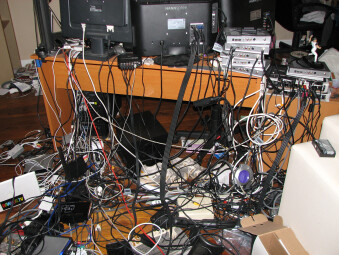From the corner of a bedroom to the living room or a garage, the home studio always ends up adapting to the elements. As usual, it all boils down to your own needs, means and possibilities.
The first problem you’ll face when conceiving your home studio will be how much space you can allocate to it. It will obviously depend on whether you have to fit it into a 160 sq ft room or a 2000 sq ft loft, or if you live by yourself or with your family, or if you have neighbors or not.
The more space you have, the more comfortable you can be and the more things you can do, both in terms of recording and placement of gear. I’ll assume that most musicians won’t have a 320 sq ft room close to home to dedicate as a studio. So I’ll focus on the most common situation the majority of musicians face, namely having to make do with an attic or sharing an apartment.
Problems with neighbors and roommates
First of all you have to admit that making music, writing songs, recording them and producing them can be a real pain for anybody around you. While you probably think it’s great to be able to play the same two bars in loop for two hours straight in order to get the arrangement or mix right, the people around you might think otherwise, especially if they aren’t into the same music you are.
And even if they are willing to put up with this out of love, never forget that it’s a concession they are making and it can nevertheless be a burden on your relationships in the long run. Always keep in mind that your neighbors don’t owe you anything. Actually, you owe them some peace and quiet. The law says so.
Depending on local laws, there is usually quiet time after 10pm or 11pm, but that’s not all. Excessive, unnecessary and unreasonable levels of noise at night are less tolerated, but that doesn’t mean that you can make all the noise you want during daytime. The annoyance depends on the level and duration of the occurrence. And we are not talking here about a simple fine (which could well go up to several thousand dollars). Depending on what happened, you might even have to face trial.
And the law doesn’t distinguish between amateurs and professional musicians. You want play some music? Go ahead, but make sure that you don’t disturb anybody else while at it. It goes beyond what the law says, it’s a matter of respect for the others. And it’s your responsibility as a musician. Remember that you represent music and your fellow musicians everywhere and, as such, you need to make sure that music remains a pleasure to anybody listening and not a source of suffering, not in Guantanamo, not inside dressing rooms, not blasting from your neighbor’s speakers, not anywhere. Music that makes you suffer is not music, it’s violence.
That implies installing your home studio where it will annoy your neighbors less. Whenever possible, try not to place it near common walls and try for ground or top floors, so you can spare a neighbor on top or below you (in this regard, ground floors are better because sound travels easier downwards than upwards, especially since your gear will most probably be in contact with the floor but not the ceiling). Renting a space in a commercial building can also be a wise decision, since you’ll hardly have any neighbors after office hours and, besides, most people get less exasperated if annoyed at the office than at home.
And never forget that “Sorry, I’m a musician and can’t do anything about it” isn’t a valid argument. There’s always something you can do about it: get a pair of headphones, invest in some acoustic insulation, rent a place especially designed to make music, or… you could always just stop. If you are unfairly and unnecessarily disturbing the peace of your neighbors, the law most probably won’t be on your side.
Hell is other people… or not?
If you live on your own, nothing stops you from changing your entire place into a home studio. You could record vocals in the closet, guitars in the living room. mix in your room…But if you share the same space with your partner, kids, parents, or roommates you will need to make sure that your passion doesn’t annoy them.
Obviously, the first thing that comes to mind is the sonic annoyance: If you set up your home studio right next to the TV set or plan to mount huge monitor speakers on a wall separating your room from that of your kids or parents, you may well be in for a rough ride. But it’s not only a matter of noise, size and aesthetics also play a role. When you’ve spent so much time decorating your home and making it a comfortable place to live in, you probably don’t want to ruin everything putting a couple of big black speakers in the middle of the room with a bunch of tangled cables running across the floor, now do you?
Rather than resorting to the sexist concept of the WAF (Woman/Wife Acceptance Factor), you should consider the OAF (Other Acceptance Factor), which basically consists of paying attention to the opinion of others when it comes to the size and location for your home studio. The fact that your partner has agreed to let you put your gear in a corner of the living room doesn’t mean that you can turn the place into a discotheque. To cut it short, you need to have a good idea of what your needs are in terms of space and also the trade-offs you’ll have to make depending on the space you have at your disposal.
Other factors to consider
The human factor (your family, neighbors, etc.) is obviously the most important issue, but there are other practical things you need to take into account, too:
- Insulation: The place you choose ought to be as insulated as possible from external noises.
- Acoustics: Choose a place with the least reverberation possible (clap your hands to test it), and try to avoid glass, tiles, and cement walls. If you don’t have a choice, you can improve things (as we will see later on).
- Electricity: Try to have a separate electrical wiring for your gear so it’s not shared with the freezer, for instance. That way you’ll avoid buzz, hum and current variations that can ruin your work.
That said, starting with the next article we’ll look at the different tips and tricks to try to correct the hundreds of defects the place you choose will likely have, or at least to improve a couple of things.




